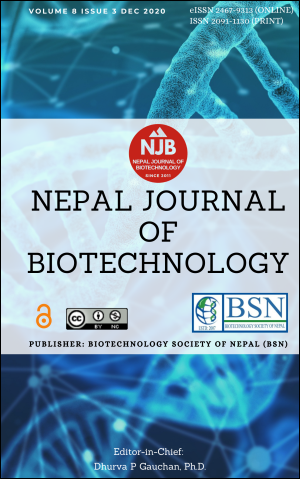Selection of Pyramided Barley Advanced Lines for Stripe Rust, Leaf Rust and Crown Rust Diseases Using Molecular Markers
DOI:
https://doi.org/10.3126/njb.v8i3.33665Keywords:
Rust, Pyramiding, Advanced lines, Barley, Marker Assisted Selection (MAS)Abstract
Barley diseases are the major yield limiting factors for barley cultivation in Nepal. Stripe/Yellow rust (P. striformis f.sp. hordei and P. striformis f.sp. tritici), leaf rust (Puccinia hordei), and crown rust (P. coronata) are the major rust diseases in Nepal. Pyramiding resistance genes against all these rust diseases are possible through molecular marker assisted breeding. Sweden originated barley variety ‘Bonus’ is found resistant to stripe rust and having linked microsatellite markers for stripe rust and crown rust resistance. Similarly, Nepalese hull-less barley variety ‘Solu Uwa’ and Nepalese awn-less barley landrace NPGR Acc# 2478 have linked microsatellite markers for leaf rust resistance. Therefore, one polymorphic sequence tagged sites (STS) marker (ABG054) for stripe rust resistance, two polymorphic simple sequence repeats (SSR) markers (Bmac0144h and HVM049) for leaf rust and one polymorphic SSR marker (Bmag0006) for crown rust resistance were used to select the advanced barley lines (at F8 stage) from above parents. Field screening of stripe rust resistance was also conducted. Among 51 advanced and field disease resistance lines from Bonus/Solu Uwa cross, we have selected 10 pyramided lines for all three types of barley rust resistance. Similarly, among 39 advanced and field disease resistance lines from Bonus/NPGR Acc#2478 cross we have selected three pyramided lines and advanced for further yield testing for general cultivation purpose. The chances of losing the desired gene are high in late generation selection using molecular marker assisted selection (MAS); but the chances of getting agronomically superior varietal output will also increase.
Downloads
Downloads
Published
How to Cite
Issue
Section
License
Copyright Notice:
The manuscript submitted to NJB must be an original contribution, not previously published and should not be under consideration for publication elsewhere. When the manuscript is accepted for publication, the authors agree to automatically transfer the copyright of the article to the publisher. It should grant permission to any third party, in advance and in perpetuity, the right to use, reproduce or disseminate your article, according to the NJB copyright and license agreement.
Authors transfer copyright to the publisher as part of a journal publishing agreement but have the rights to: Share their article for Personal Use, Internal Institutional Use and Scholarly Sharing purposes, with the NJB applies the Creative Commons Attribution-NonCommercial CC BY-NC license to all the works we publish after Jun 2020 (Before it was CC BY-NC-ND). Under this license, authors agree to make articles legally available for reuse, without permission or fees, for virtually any non-commercial purpose. Anyone may remix, adapt, and build upon your work non-commercially, and although their new works must also acknowledge you and be non-commercial, they don’t have to license their derivative works on the same terms. More details on CC BY-NC refer to its Licence Deed and Legal Code.






